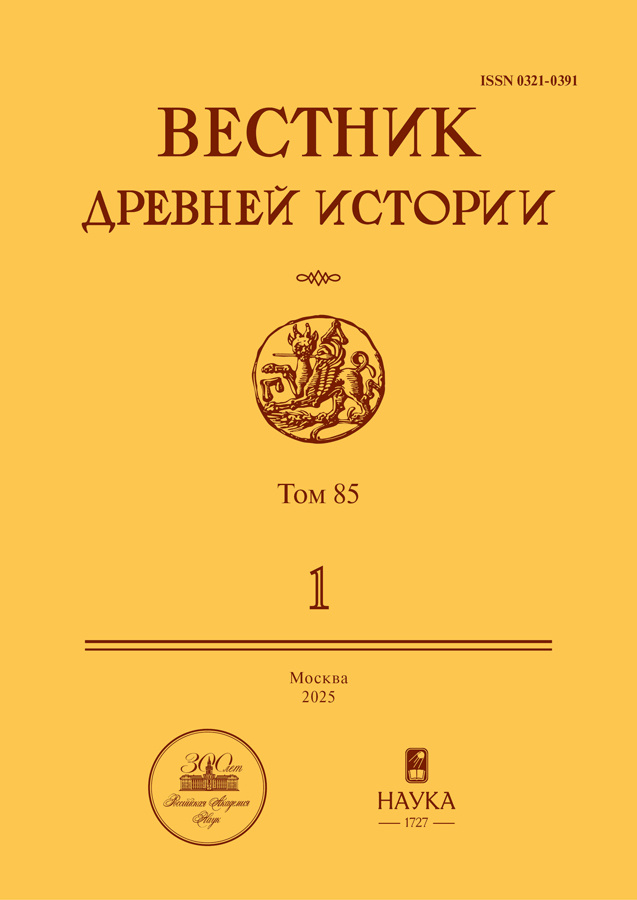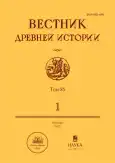Vol 85, No 1 (2025)
Articles
Monuments of the jj-nfr family from Saqqara and their fate
Abstract
The article contains a commentary to the texts on two monuments of the jj-nfr family, discovered during the excavations of Ahmed Moussa in 1968–1970 and deposited in the Saqqara Magazine under Reg.No.16268 (stela) and Reg.No.16299 (lintel). Special attention is paid to the epitaph on the lintel Saqqara Magazine Reg.No.16299, the title kᴣtj ptḥ «worker of Ptah», which was held by the owner’s son, named rꜥ-ḥtp, as well as images of the women with a flower diadem on their head. It has been established that the largest part of the stele Reg.No.16268 was put up for auction in March 1994 at the Drouot Richelieu auction in Paris, apparently through illegal means.
 5-17
5-17


‘Cultic reforms’ of the Kings of Judah in the light of archaeological data
Abstract
This article provides an overview of the archaeological aspect of the debate on the historicity of cultic reforms described in 2 Kings, initiated by the Judean kings Josiah (late seventh century BC) and Hezekiah (late eighth – early seventh century BC), aimed at the abolition of sanctuaries outside Jerusalem. The discussion focuses on the potential archaeological evidence of these reforms: the dismantled temple at Tel Arad, the possibly desecrated ‘gate shrine’ at Lachish, and the eliminated altar at Beersheba. The examined data does not provide definitive confirmation of the historicity of these reforms.
 18-44
18-44


Post hoc or propter hoc? Some reflections on the relationship between the adoption of lex iulia de civitate and the revolt in Etruria and Umbria in the end of 90 bc
Abstract
The article offers a detailed analysis of the information of Appian and other sources concerning the revolt of the Italic communities of Etruria and Umbria and the passing of the lex Iulia de sociis et Latinis civitate danda in order to establish a causal relationship between these events. Although the Julian law was passed after, rather than as a result of, the Etrurian and Umbrian uprising, a link between these events still existed: the uprising accelerated the adoption of the Julian law and influenced its final content. The Julian law enfranchised not only loyal Italian allies, but also the so-called dediticii. For the latter, a particular procedure was provided: dediticii, if they wished to become Roman citizens, had to apply to the praetor urbanus, who had to announce the senate’s decision in the Popular Assembly, where it would be eventually ratified.
 45-62
45-62


Eighth Michael I. Rostovtzeff lecture
Cleruchic land: Athens, Macedon, and the Hellenistic kingdoms
Abstract
This brief piece is an introduction to the dossier of four papers dedicated to the memory of Michael Rostovtzeff on the topic of cleruchy, which shows that not only the legal framework governing the settling of settler soldiers in the Hellenistic kingdoms was inherited from that of Macedon (which does not mean that it was everywhere the same) but also that there was a common Greek archetype to the cleruchic system, as suggested by the late Archaic statute of the Athenian cleruchy in Salamis.
 63-68
63-68


Salamis: an archaeology of the Athenian cleruchic system
Abstract
Through an investigation on the creation of the Athenian cleruchy in Salamis at the end of the Archaic period, this article provides an ‘archaeology’ of the cleruchic system. It starts from an analysis of the late Archaic inscription that stipulates the regulations applying to the holders of cleruchic land. Then, after a short reanalysis of the war between Athens and Megara over the possession of Salamis, it moves on to the question of the origin of the genos of the Salaminioi, for which it provides a new solution that is linked to the circumstances of the creation of the cleruchic settlement in Salamis. The article concludes by examining the structural and defining conditions of the creation of a cleruchy.
 69-84
69-84


The polis and royal power in the Bosporus during the Spartokid era: lands, citizenship and taxes
Abstract
The article shows that the state structure of the Bosporan kingdom from the end of the fifth century BC until its conquest by Mithradates was very peculiar and had no close analogues in the Greek world. The Greek cities incorporated into the kingdom lost their civic institutions, autonomy, and even citizenship. The citizenship of the poleis was replaced by the common Bosporan citizenship, from which, however, only the name was preserved: the citizens became subjects. All the prerogatives of the polis – starting with the right to grant citizenship and ending with the control of finances, regulation of trade and legislation – were ceded to the ruling dynasty of the Spartokids. Theodosia preserved a separate status, but there too the range of rights enjoyed by the civic community did not differ from the Bosporan ones. The klerouchoi existed in the Bosporan kingdom and they had obligations to fulfil directly to the Bosporan tyrants. The civic communities in the Bosporus were recreated only by Mithradates, who reproduced the political structure familiar to him: the system of Greek poleis within the Hellenistic monarchy. It can be assumed that this political structure was inherited by the Spartokids from their predecessors Archaianaktidai. The Archaianaktidai were probably brought to power by the Achaemenids, who seem to conquer the Bosporus c. 480 BC. In support of the hypothesis of Persian control of the Bosporus under the Archaianaktidai, in addition to the arguments already brought by other scholars, a new one is given – the idenfitication of column bases found on the acropolis of Pantikapaion as Achaemenid ones.
 85-108
85-108


The cleruchy in hellenistic Egypt
Abstract
Information from recently published papyri is combined with papyrological and epigraphical data already known to examine the current state of knowledge of the role of cleruchic land in Hellenistic Egypt. Over time, a system that started as a means of rewarding elite Macedonian cavalry forces and of tying them to their new home was extended to the infantry and different ranks of the police force. Furthermore, as Ptolemaic concerns developed in the second century BC, the institution was opened up and key local Egyptian families are found as recipients of cleruchic land, at least in Upper Egypt where the regime was subject to on-going threat. Members of such well-established families are shown to have been important in administrative and religious, as well as in the military sphere. Finally, attention is drawn to changing local differences in the fiscal relationship of cleruchic land to the central royal treasury.
 109-119
109-119


Military land allotments in ancient Egypt
Abstract
The ancient Egyptians had a long tradition of allotting land to soldiers. From the beginning of the sixteenth century BC at the latest, land in Egypt and possibly in Nubia as well was sometimes given to demobilized Egyptian and foreign soldiers as a reward for service and possibly as a means of support between military campaigns. From the seventh century BC onwards, some land in Egypt appears to have carried an explicit obligation for its holders for military service when called for duty. These traditions are distinct from the Athenian system of cleruchies in the sixth through fourth centuries BC, in which the service obligation was linked to citizenship. Consequently, both the Egyptian traditions and the Athenian system may have informed and influenced the Ptolemaic system of cleruchies in Egypt in the fourth through second centuries BC, as Michael Rostovtzeff suggested already in 1941.
 120-132
120-132


Publications
New finds of figurative vessels of the roman period from the vicinity of Chersonesos
Abstract
The article is dedicated to the study of two red slip vessels discovered during the construction works on the Tavrida highway in Crimea – a figurative vessel in the form of a bull and a fragmented patera with a relief gorgoneion in the centre of the bottom. Complete analogies to the first vessel, dated to the last quarter of the first century AD and made in an unidentified centre in Asia Minor, were never found, despite a significant number of morphologically similar smaller vessels dating back to Hellenistic times. The fragmented Knidian patera is easily restored thanks to a direct parallel – a find from the necropolis ‘Sovkhoz No. 10’, and dates back to the first half of the second century AD.
 133-162
133-162


Pages of historiography
The Russian Archaeological Institute in Constantinople and M.I. Rostovtzeff
Abstract
The article briefly traces the main milestones in the history of the Russians Archaeological Institute in Constantinople (RAIC, 1894–1914), which was the only Russian academic institution outside the Russian Empire. The Institute mostly engaged in the studies of the Christian East, including the collection of epigraphic material throughout the Ottoman Empire. The collections of the institute’s squeezes are kept now in the St. Petersburg Branch of the Archive of the RAS and in the Research Archive of the Institute for the History of Material Culture of the RAS. Based on M.I. Rostovtzeff’s correspondence with his teachers and colleagues, we have managed to reconstruct the history of his relationships with the director of the RAIC, academician F.I. Uspensky. At his request, M.I. Rostovtzeff used to examine the ancient epigraphic material that had been collected by the RAIC in Macedonia.
 163-185
163-185


Critical and bibliographical surveys
L. Pernot. Confluences de la philosophie et de la rhétorique grecques. Paris, 2022
 186-198
186-198


New books about Antoninus Pius and his age
 199-213
199-213


News and events
‘Lomonosov conference’ at the departments of ancient languages and ancient history of the faculty of history of the Lomonosov Moscow State University (Moscow, March 26 and April 1, 2024)
 214-217
214-217


Annual academic conference ‘Civilizations of the ancient Near East and antiquity: historical dynamics of common and specific’ (Moscow, June 10–11, 2024)
 218-228
218-228


Personalia
The anniversary of Sergey Karpyuk
 229-230
229-230


Supplement
Silius Italicus. on the siege of Saguntum (Punica I. 271 – II. 707)
 231-268
231-268










